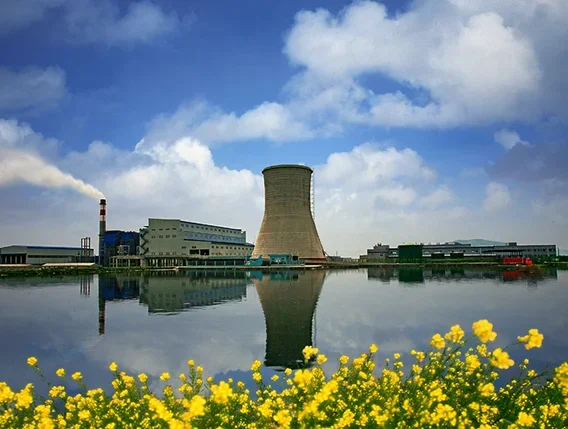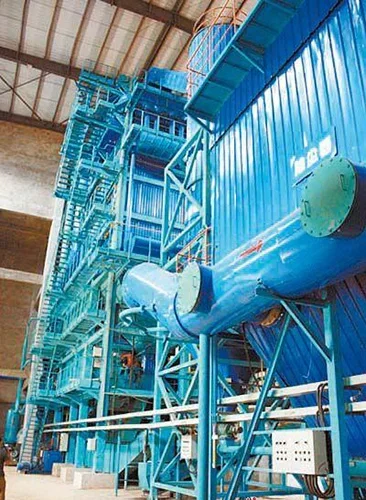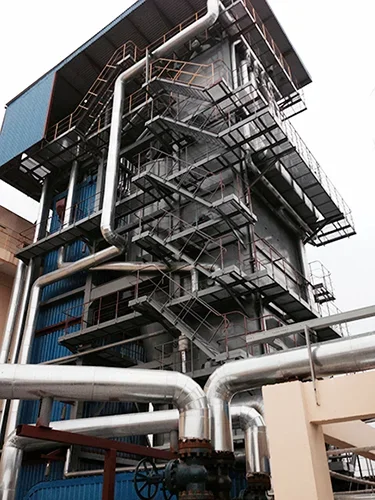The circulating fluidized bed boiler is a crucial technology in the energy sector, offering efficient and environmentally friendly solutions for power generation. This innovative boiler design enhances combustion efficiency, reduces harmful emissions, and accommodates a variety of fuel types. With its ability to handle coal, biomass, and waste fuels effectively, the circulating fluidized bed boiler stands out as a versatile and sustainable option for power plants worldwide. By promoting better fuel utilization and lower pollutant release, this technology aligns with the growing focus on clean energy production. Stay tuned to explore the benefits and applications of circulating fluidized bed boilers in the upcoming discussion.
Understanding Fluidization Regimes
Bubbling Fluidized Bed (BFB) Systems
Bubbling fluidized bed (BFB) systems operate at minimum fluidization conditions, where solid particles are suspended by upward gas flow. The gas velocity profile in BFBs is lower than that in circulating fluidized bed (CFB) systems.
Circulating Fluidized Bed (CFB) Systems
In circulating fluidized bed (CFB) systems, the solids fluxes are higher due to faster gas velocities. These systems exhibit better heat transfer and mixing characteristics compared to BFBs.
Fast Fluidization Dynamics
Fast fluidization involves high gas velocities that keep solid particles in a state of suspension. The erosion rate in fast fluidization is higher due to increased particle velocities.
Pneumatic Transport Regime
Pneumatic transport occurs at even higher gas velocities than fast fluidization, leading to efficient solids conveying. The pressure drop in pneumatic transport regimes is significant due to increased gas density.
Importance of Particle Behavior
The behavior of solid particles is crucial for achieving optimal fluidization conditions. Understanding the solids velocity and how it interacts with gas flow is key to maintaining system efficiency.
Classifying Circulating Fluidized Bed Boilers
Size and Capacity
Circulating fluidized bed (CFB) boilers are categorized based on size and capacity, with distinctions between small-scale and large-scale applications. Small-scale CFB boilers are typically used for industrial processes and district heating, while large-scale ones are prevalent in power plants.
Large-scale CFB boilers have a greater capacity to handle higher steam parameters, making them ideal for electricity generation. On the other hand, small-scale CFB boilers are more versatile and can efficiently combust a variety of fuels, including biomass and coal.
Fuel Type Designs
CFB boiler designs vary significantly depending on the type of fuel being utilized. For instance, biomass-fired CFB boilers incorporate features like specialized combustion systems to optimize the burning of biomass particles efficiently. These designs ensure high combustion efficiency while minimizing emissions.
In contrast, coal-fired CFB boilers are engineered with robust ash management systems to handle the higher ash content present in coal. The design also includes advanced sorbent injection technology to control sulfur dioxide emissions effectively.
Operational Features
When it comes to operational features, there is a distinction between subcritical and supercritical CFB boilers in power generation. Subcritical CFB boilers operate at lower temperatures and pressures compared to their supercritical counterparts.
Subcritical CFB boilers are known for their flexibility in handling various fuel types and their ability to adapt quickly to changing load demands. Conversely, supercritical CFB boilers offer higher efficiency levels due to operating at elevated temperatures and pressures, resulting in better overall plant performance.

Core Technology of CFB Boilers
Bed Inventory
Bed inventory plays a crucial role in CFB combustion, ensuring efficient heat transfer and optimal fuel burning. The bed's capacity to store solids helps maintain stable combustion temperatures.
The bed inventory in CFB boilers provides a reservoir for maintaining the required temperature levels, aiding in achieving complete combustion. This feature enhances the boiler's efficiency by allowing for better control over the combustion process.
Cyclone Separators
Cyclone separators are integral components of CFB boilers, enhancing combustion efficiency by separating solid particles from flue gas. By removing solids, these separators prevent erosion in downstream equipment.
In CFB boilers, cyclone separators help reduce emissions by capturing solid particles before they are released into the atmosphere. This process not only improves environmental performance but also prolongs the lifespan of the equipment.
Heat Transfer Mechanisms
Efficient steam generation in CFB boilers relies on heat transfer mechanisms, where heat is transferred from the fluidized bed to water tubes through convection and radiation. This process ensures optimal energy conversion.
In CFB boilers, heat transfer occurs through convection and radiation, maximizing the utilization of thermal energy for steam generation. The design of these boilers facilitates efficient heat exchange, leading to high steam production rates.
Advantages of Circulating Fluidized Bed Boilers
Environmental Benefits
Circulating fluidized bed (CFB) boilers offer low emissions of sulfur oxides and nitrogen oxides, contributing to cleaner air quality. This technology significantly reduces harmful pollutants released into the atmosphere. The improved combustion efficiency in CFB boilers minimizes environmental impact by burning fuel more effectively.
Economic Advantages
One of the key advantages of CFB boilers is their ability to utilize diverse fuel sources, leading to cost-effective energy production. By accommodating various fuels such as biomass, coal, and waste materials, CFB boilers provide economic benefits through efficient energy generation. This versatility in fuel options helps in reducing operational costs and enhancing overall profitability.
Operational Flexibility
CFB boilers exhibit exceptional operational flexibility by adapting to varying fuel qualities and loads. Their unique design allows for efficient combustion even with fuels of different properties, ensuring consistent performance under changing conditions. This adaptability enhances the operational efficiency of CFB boilers, making them suitable for a wide range of industrial applications.
Limitations of Circulating Fluidized Bed Boilers
Ash Management
Ash management poses a significant challenge in circulating fluidized bed (CFB) boilers due to the high ash content in solid fuels like coal. The combustion chamber temperature and pressure variations can lead to agglomeration, affecting the boiler's operational efficiency.
The formation of agglomerates in CFB boilers can result from the high combustion temperatures required for efficient coal combustion. These agglomerates can impact the combustion efficiency, leading to reduced overall performance.
Fuel Quality Variability
The fuel flexibility of CFB boilers, while advantageous, also introduces challenges related to fuel quality variability. Fluctuations in fuel quality can significantly affect the combustion efficiency and overall performance of the boiler system.
In scenarios where sulfur content in the solid fuels varies, it can directly impact the emission control capabilities of CFB boilers. Maintaining optimal combustion conditions becomes crucial to mitigate any adverse effects on environmental regulations.
Ultra-Supercritical Steam Conditions
While CFB technology offers various advantages, achieving ultra-supercritical steam conditions remains a limitation compared to other boiler types. The design constraints of CFB systems may hinder their ability to operate efficiently at such high temperatures and pressures.
When aiming for ultra-supercritical steam conditions, factors like combustion efficiency, heat transfer rates, and material limitations need meticulous consideration. These challenges highlight the complexity involved in pushing CFB technology towards higher performance standards.

Design and Operation Insights
Optimization Considerations
Operating conditions play a crucial role in maximizing the efficiency of circulating fluidized bed (CFB) boilers. By adjusting parameters such as feed points and dispersion, operators can achieve optimal combustion rates.
When designing CFB systems, ensuring flexibility is essential to accommodate a wide range of fuel types. This versatility allows for efficient utilization of various resources and enhances the overall capacity of the boiler.
Operational Strategies
To prevent tube erosion and maintain stable operation, it is vital to carefully manage the cycle of the boiler. Implementing a well-planned maintenance schedule helps in prolonging the lifespan of key components within the unit.
The concept of plug flow within CFB boilers aids in achieving uniform heat distribution, contributing to improved thermal efficiency. By focusing on maintaining proper center dispersion, operators can ensure consistent performance.
Advanced Control Systems
The integration of advanced control systems significantly impacts the overall performance of CFB boilers. These systems enable precise regulation of power requirements, leading to enhanced electricity generation capabilities.
Evaluating Process Characteristics
Thermal Efficiency
Assess thermal efficiency by analyzing the heat transfer mechanisms within circulating fluidized bed (CFB) boilers. Varying operating conditions significantly influence the boiler's efficiency. The ability to maintain optimal temperatures enhances overall performance.
Evaluate how different parameters such as airflow velocity and bed material properties impact thermal efficiency. The scale of operations also plays a crucial role in determining the effectiveness of heat transfer processes within CFB boilers.
Combustion Performance and Emissions Control
Examine the influence of bed material properties on combustion performance in CFB systems. The quality of the bed material affects combustion stability and pollutant emissions control. Understanding these dynamics is essential for maintaining efficient operations.
Compare the radial distribution of particles in CFB boilers with other combustion technologies. The parabolic velocity profile characteristic of CFB systems influences combustion efficiency and emission levels. Analyzing these profiles helps optimize performance.
Process Dynamics Comparison
Contrast the process dynamics of CFB boilers with those of bubbling fluidized bed (BFB) or circulating entrained flow bed (CEFB) technologies. Each system exhibits unique characteristics affecting combustion behavior and heat transfer efficiency.
Explore the impact of axial dispersion coefficient on process dynamics in CFB boilers. Understanding how particles disperse along the height of the boiler enhances operational control and efficiency improvements.
Applications of CFB Boilers
Industrial Diversification
CFB boilers find extensive applications in various industries, not limited to power plants. Industries such as chemical and petrochemical sectors benefit from the flexibility and efficiency of CFB technology. The ability to burn a wide range of fuels makes CFB boilers versatile for diverse industrial processes.
The adaptability of CFB boilers allows for efficient steam generation in chemical plants, where stringent process requirements demand reliable and stable operations. In the petrochemical industry, CFB boilers play a crucial role in providing heat and power for various refining processes.
Sustainable Energy Solutions
In the realm of sustainable energy initiatives, CFB boilers emerge as key players in reducing carbon footprints. By enabling the co-firing of biomass and waste materials alongside conventional fuels, CFB technology promotes environmentally friendly practices. This approach not only reduces greenhouse gas emissions but also contributes to resource conservation.
-
Pros:
-
Versatile fuel options
-
High efficiency in steam generation
-
Reduced environmental impact
-
Future Outlook and Market Trends
The future prospects of CFB boilers appear promising, especially in emerging markets seeking energy-efficient solutions. As renewable energy gains traction globally, CFB technology is poised to play a significant role in facilitating the transition towards cleaner energy sources. The scalability and adaptability of CFB boilers make them ideal for integrating with renewable energy systems.
Embracing advancements in combustion technologies, CFB boilers are set to enhance their efficiency further while maintaining environmental sustainability standards. With ongoing research and development efforts focused on optimizing performance and reducing operational costs, CFB boilers are positioned to drive innovation in the energy sector.

Summary
The exploration of circulating fluidized bed boilers has unveiled a versatile technology with distinct advantages and limitations. Understanding the fluidization regimes, core technology, design insights, and various applications sheds light on the operational intricacies and potential efficiencies of these boilers. While the advantages such as fuel flexibility and low emissions make them attractive in certain contexts, considerations regarding particle size, erosion, and maintenance present notable challenges. Evaluating process characteristics provides a comprehensive view for industries considering the adoption of circulating fluidized bed boilers.
For those delving into the realm of energy production or industrial processes, a thorough grasp of circulating fluidized bed boilers is paramount. By weighing the benefits against the constraints and leveraging design insights, informed decisions can be made to optimize performance and sustainability. Embracing this technology requires a nuanced approach that balances innovation with practical considerations, paving the way for enhanced operational outcomes.
Frequently Asked Questions
What are the different fluidization regimes in circulating fluidized bed boilers?
In circulating fluidized bed boilers, the main fluidization regimes include fast fluidization, turbulent fluidization, and pneumatic transport. Fast fluidization involves solid particles suspended in an upward flow of gas, while turbulent fluidization exhibits chaotic movement of particles. Pneumatic transport is characterized by high-velocity gas carrying solid particles.
What are the core technologies used in circulating fluidized bed boilers?
The core technologies in circulating fluidized bed (CFB) boilers include a loop seal design for gas-solid separation, a primary air fan for combustion control, and a heat exchanger to recover energy from flue gases. These technologies contribute to the efficiency and performance of CFB boilers.
What advantages do circulating fluidized bed boilers offer over traditional boiler systems?
Circulating fluidized bed boilers offer advantages such as fuel flexibility, reduced emissions of pollutants like sulfur dioxide and nitrogen oxides, efficient combustion of low-grade fuels, and enhanced heat transfer due to the intimate mixing of solids. These benefits make CFB boilers a preferred choice for various industrial applications.
What are the limitations associated with circulating fluidized bed boilers?
Limitations of circulating fluidized bed boilers include high initial investment costs, challenges in controlling particle size distribution, potential erosion of heat transfer surfaces due to high solid circulation rates, and sensitivity to fuel quality variations. Addressing these limitations requires careful design and operational considerations.
How are process characteristics evaluated in circulating fluidized bed boiler applications?
Process characteristics in circulating fluidized bed boiler applications are evaluated based on parameters like combustion efficiency, heat transfer efficiency, material balance, emission levels, operational stability, and overall system reliability. Monitoring and analyzing these factors help optimize performance and ensure safe operation of CFB boiler systems.
